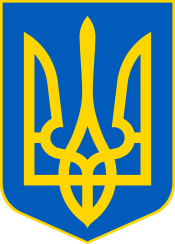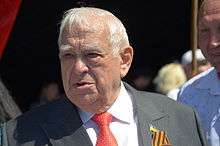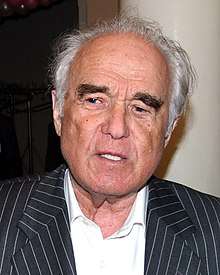1990 Ukrainian Supreme Soviet election
The first relatively free[2] election to the Supreme Soviet (Rada) held in the Ukrainian Soviet Socialist Republic (Ukrainian SSR) took place in several stages, from March 4 to March 18, 1990. The elections were held to elect deputies to the republic's parliament, the Verkhovna Rada. Simultaneously, elections of local provincial ("oblast'") councils also took place in their respective administrative divisions.
| ||||||||||||||||||||||
All 450 seats of the Verkhovna Rada of the Ukrainian SSR 226 seats were needed for a majority | ||||||||||||||||||||||
|---|---|---|---|---|---|---|---|---|---|---|---|---|---|---|---|---|---|---|---|---|---|---|
| Turnout | 85% (first round)/79% (second round)[1] | |||||||||||||||||||||
| ||||||||||||||||||||||
| ||||||||||||||||||||||
The election was the closest thing to a free election Ukraine had seen since the unfinished 1918 Constituent Assembly elections. Although the electoral campaign was far from being clear and transparent, representatives of the Democratic Bloc were the first to provide a legal challenge to the authority of the Communist Party of the Ukrainian SSR in parliament. A total of 442 National Deputies were elected – short of the 450 seat total, due to low voter turnout.
The parliamentary convocation that convened after the 1990 election declared the independence of Ukraine from the Soviet Union on August 24, 1991. Later on, an amendment to the official number of parliamentary convocations recognized this 12th Convocation of the Parliament of the Ukrainian SSR as the first Parliament of Ukraine of the 1st Convocation.
Background
In the wake of Mikhail Gorbachev's perestroika, the Law on Elections – adopted on October 27, 1989 – included provisions for direct elections of individuals (as opposed to group representation of civic organizations), the need for alternative (non-Communist) candidates, the elimination of a requirement for nomination meetings, and other relatively democratic provisions.[3] However, the elections were far from being free – as the Communist Party retained control on the media, exerted political influence, and had a large financial resource base.[2]
During the election campaign, the self-titled "Democratic Bloc" was formed, which included the People's Movement of Ukraine (Rukh), the Helsinki Watch Committee of Ukraine, the Green Party of Ukraine, and many other organizations.[4]
Results
The elections took place according to the majoritarian electoral system in 450 electoral regions. The first round of elections took place on March 4, 1990. In electoral regions where none of candidates obtained at least 50% of the vote, a second round of elections took place on March 10–18.[5] In two rounds of elections a total of 442 deputies were elected,[5] not reaching the maximum 450 deputies due to low voter turnout.
The Communists obtained 331 seats in the Rada. The Democratic Bloc obtained 111 seats out of 442.[5] In the parliament, the democratic deputies formed the "Narodna Rada" (People's Council) group, which consisted of 90 to 125 members.[6] Narodna Rada became the opposition bloc to the parliamentary majority and Ihor Yukhnovskyi was elected as the opposition group's leader.
Factions
- Group of 239 (Communist Party of Ukraine) – 239
- People's Council (People's Movement of Ukraine) – 125
- CPU Democratic platform (Party of Democratic Revival of Ukraine) – 41
- Democratic Party of Ukraine (Democratic Party of Ukraine) – 19
- Ukrainian Republican Party (Ukrainian Republican Party) – 12
- Unaffiliated members of parliament
Aftermath
 |
|---|
| This article is part of a series on the politics and government of Ukraine |
| Constitution |
|
|
The first meeting of the Parliament took place on May 15, 1990. The Communist deputies elected Volodymyr Ivashko to serve as the Parliament Chairman, but on July 19, 1991 he chose to move to Moscow for the position of Deputy General Secretary of the Communist Party of the Soviet Union. The Ukrainian Communists were rapidly losing popularity; by July 1990 ninety-two of the deputies elected as Communists declared themselves as "Independents". The remaining 239 communist deputies formed a new majority group they called "For a Soviet Sovereign Ukraine", informally known as the "group of 239".[4]
On July 16, 1990, this Parliament adopted the Declaration of State Sovereignty of Ukraine. The Declaration was supported by 355 deputies.[5]
On July 18 the "For a Soviet Sovereign Ukraine" group led by Oleksander Moroz[7] elected Leonid Kravchuk as the Chairman of Parliament.[8]
On 24 October 1990, the Parliament amended the 1978 Constitution of the Ukrainian SSR, in particular to exclude Article 6.[9] Prior to the amendments, the supreme governing body of the Ukrainian SSR was the Central Committee of the Communist Party of the Ukrainian SSR.
On 24 August 1991 the parliament declared Ukraine independent and called for a referendum on support for the Declaration of Independence.[7][10] In the following days it also banned the Communist Party of Ukraine and nationalized its property (this ban was only theoretical since de facto the Communist elite continued to rule the country).[7][11]
On December 5, 1991 Leonid Kravchuk surrendered his parliamentary duties to accept the presidency of an independent Ukraine. The post of Parliament Chairman was awarded to Ivan Plyushch. On June 18, 1992 several other parliamentarians left the "People's Council" group; among them were Levko Lukyanenko, Pavlo Lazarenko, Anatoliy Kinakh, and many others.
After the banning of the Communist Party of Ukraine, remnants of its elected deputies (the "group of 239") joined other left-wing parties; most became independent politicians.[12]
Statistics
The first convocation had eight sessions where 85 legal documents were submitted. Six of the legal projects were initiated by the President of Ukraine and 38 by the Cabinet of Ministers. The most productive sessions were the last two (the 7th and 8th) where 60 legal projects were submitted.
Government leaders
Below is a list of the Chairmen of the 1st Convocation of the Verkhovna Rada of Ukraine.
| Name | Party/Bloc | Date Elected | Date Resigned | Convocation | Comments |
|---|---|---|---|---|---|
| Volodymyr Ivashko | Communist | June 4, 1990[13] | July 9, 1990 | 1 (12) | Resigned when elected to the Politburo of the CPSU. |
| Leonid Kravchuk | July 23, 1990[14] | December 5, 1991 | 1 (12) | Resigned as a result of his election as President. | |
| Ivan Plyushch | Independent | December 5, 1991[15] | May 11, 1994 | 1 (12) |
Prime Minister
Note: an appointment to this office had little influence from the Verkhovna Rada until the constitutional reforms of 2004.
| # | Picture | Name | Took office | Left office | Party | Notes |
|---|---|---|---|---|---|---|
| 1 |  | Vitold Fokin | 23 October 1990 | 2 October 1992 | Communist Party of the Ukr. SSR / Non-partisan | acting to 14 November 1990 (continued from above) |
| — | Valentyn Symonenko | 2 October 1992 | 13 October 1992 | Non-partisan | acting | |
| 2 | .jpg) | Leonid Kuchma | 13 October 1992 | 22 September 1993 | Non-partisan | |
| — |  | Yukhym Zvyahilsky | 22 September 1993 | 16 June 1994 | Non-partisan | acting |
| 3 |  | Vitaliy Masol | 16 June 1994 | 1 March 1995 | Non-partisan |
See also
- List of members of the parliament of Ukraine, 1990–1994
References
- Ukrainian Nationalism in the 1990s: A Minority Faith by Andrew Wilson, Cambridge University Press, 1996, ISBN 0521574579 (page 120)
- Subtelny, Orest (2000). Ukraine: A History. University of Toronto Press. pp. 576. ISBN 0-8020-8390-0.
- Історія українських виборів (1990 р., 1994 р., 1998 р.) (in Ukrainian).
- Subtelny, p. 577.
- КАЛІНІЧЕНКО В.В., РИБАЛКА І.К. ІСТОРІЯ УКРАЇНИ. ЧАСТИНА ІІІ: 1917-2003 рр. (in Ukrainian). Archived from the original on 2008-05-12.
- "Trends of independence: Elections in Ukraine". kandydat.com.ua (in Ukrainian). February 1, 2006. Archived from the original on October 14, 2007. Retrieved 2008-03-02.
- Historic vote for independence, The Ukrainian Weekly (1 September 1991)
- Технологія незалежності: уроки минулого століття. Доба Леоніда Кравчука (in Ukrainian).
- Laws of Ukraine. Verkhovna Rada law No. 404-XII: Amendments to the Constitution of Ukrainian SSR. Adopted on 1990-10-24. (Ukrainian)
- A History of Ukraine: The Land and Its Peoples by Paul Robert Magocsi, University of Toronto Press, 2010, ISBN 1442610212 (page 722/723)
- Communist and Post-Communist Parties in Europe by Uwe Backes & Patrick Moreau, Vandenhoeck & Ruprecht, 2008, ISBN 3525369123 (page 376)
- The Moulding of Ukraine: The Constitutional Politics of State Formation by Kataryna Wolczuk, Central European University Press, 2001, ISBN 9639241253 (page 109)
- Laws of Ukraine. Order of Verkhovna Rada No. 11-XII: On the Head of the Verkhovna Rada of the Ukrainian SSR. Adopted on 1990-06-04. (Ukrainian)
- Laws of Ukraine. Order of Verkhovna Rada No. 63-XII: On the Head of the Verkhovna Rada of the Ukrainian SSR. Adopted on 1990-07-23. (Ukrainian)
- Laws of Ukraine. Order of Verkhovna Rada No. 1930-XII: On the Head of the Verkhovna Rada of Ukraine. Adopted on 1991-12-05. (Ukrainian)
